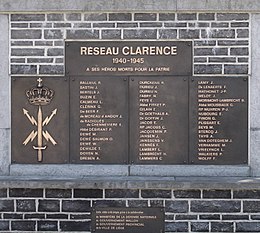Clarence network
The Clarence network (French: Réseau Clarence ) was a Belgian intelligence network that was founded by Walthère Dewé during the Second World War .
history
During the First World War, Dieudonné Lambrecht founded an underground intelligence service called Dame Blanche . After his execution by the Germans in 1916, his cousin Walthère Dewé took over the management of this network. In 1939 Walthère Dewé reactivated Dame Blanche after the British Secret Intelligence Service had contacted him on the basis of the positive experience with him, in order to rebuild a secret service network. In September 1939 he founded the Corps d'observation belge (COB), consisting of Belgian business people. Under the guise of their trade relations with Germany, these agents carried out industrial espionage in Germany to monitor German war preparations. He warns the Belgians, British and French that an invasion is imminent.
In June 1940, after the German occupation of Belgium began, Dewé and his closest colleague Hector Demarque began to spy on the Wehrmacht . Demarque's resistance name was Clarence, and that's how Dewé called the network. The first meeting of the board took place in Ixelles with an employee of the former Dame Blanche network, the now 75-year-old Thérèse de Radiguès.
The network
Clarence was modeled after the Dame Blanche network from the First World War organized. It consisted of a steering committee, nine provincial sectors, a mobile sector and a French sector. The beginning was difficult because no connection to London could be established (neither overland nor by radio). In January 1941, thanks to parachute drops from radio stations, the connection to London was made. Claude Dansey , Head of SIS, manages the contacts.
Dewé heard on January 14, 1944 that his arrest was imminent. When he tried to warn Thérèse de Radiguès, he was shot dead in the street in Brussels. Even so, the network remained in operation until the end of 1944. It could send messages by radio 872, and also 163 reports with maps, drawings and photos as well as 92 letters over France and Spain to England were smuggled. After the end of the war, 1547 resistance fighters were officially recognized as participating in this intelligence network
Claude Dansey of the SIS stated at the end of the war that the Clarence network ranks first among the military intelligence networks of all occupied territories in Europe because of the quality and volume of the messages and documents.
Web links
Individual evidence
- ↑ La résistance durant la guerre 1940-1945
- ↑ Verzet in België, Go2war2.nl
- ^ België in de Tweede Wereldoorlog. Deel 6. Het verzet 2, Rudi van Doorslaer, Etienne Verhoeyen, Herman van de Vijver (1988)
- ^ Henri Bernard, Un Géant de la Résistance, Walthère Dewé , Renaissance du Livre, 1971.
